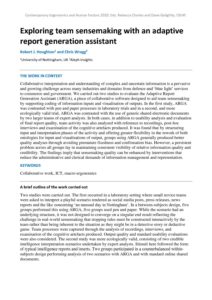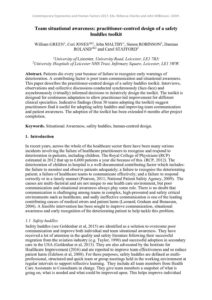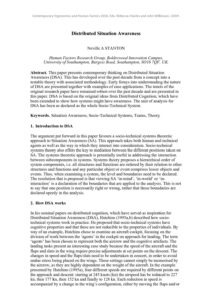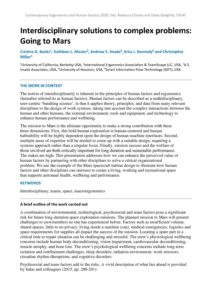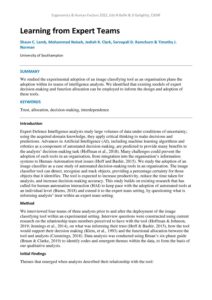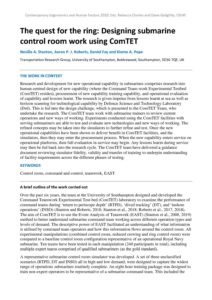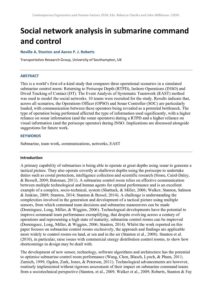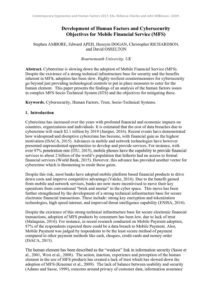Teamwork
Exploring team sensemaking with an adaptive report generation assistant
| Document | Author Robert J. Houghton and Chris Wragg |
| Abstract Collaborative interpretation and understanding of complex and uncertain information is a pervasive and growing challenge across many industries and domains from defence and ‘blue light’ services to commerce and government. We carried out two studies to evaluate the Adaptive Report Generation Assistant (ARGA), a piece of collaborative software designed to aid team sensemaking by supporting coding of information inputs and visualisation of outputs. In the first study, ARGA was contrasted with pen and paper processes in laboratory trials and in a second, and more ecologically valid trial, ARGA was contrasted with the use of generic shared electronic documents by two larger teams of expert analysts. In both cases, in addition to usability analysis and evaluation of final report quality, team activity was also analysed with reference to recordings, post-hoc interviews and examination of the cognitive artefacts produced. It was found that by structuring input and interpretation phases of the activity and offering greater flexibility in the rework of both ontologies for input and visualisations of output, groups using ARGA generally produced better quality analyses through avoiding premature fixedness and confirmation bias. However, a persistent problem across all groups lay in maintaining consistent visibility of relative information quality and credibility. The findings imply that sensemaking quality can be enhanced by interventions that reduce the administrative and clerical demands of information management and representation. |
Team situational awareness: practitioner-centred design of a safety huddles toolkit
| Document | Author William GREEN, Ceri JONES, John MALTBY, Simon ROBINSON, Damian ROLAND and Carol STAFFORD |
| Abstract Patients die every year because of failure to recognize early warnings of deterioration. A contributing factor is poor team communication and situational awareness. This paper describes the practitioner-centred design of a safety huddles toolkit. Interviews, observations and collective discussions conducted synchronously (face-face) and asynchronously (virtually) informed decisions to iteratively design the toolkit. The toolkit is designed for continuous adaptation to allow practitioner-led improvement for different clinical specialties. Indicative findings (from 50 teams adopting the toolkit) suggest practitioners find it useful for adopting safety huddles and improving team communication and patient awareness. The adoption of the toolkit has been extended 6 months after project completion. |
Distributed Situation Awareness
| Document | Author Neville A STANTON |
| Abstract This paper presents contemporary thinking on Distributed Situation Awareness (DSA). This has developed over the past decade from a concept into a testable theory with associated methodology. Early forays into understanding the nature of DSA are presented together with examples of case applications. The tenets of the original research paper have remained robust over the past decade and are presented in this paper. DSA is based on the original ideas from Distributed Cognition, which have been extended to show how systems might have awareness. The unit of analysis for DSA has been as declared as the whole Socio-Technical System. |
Interdisciplinary solutions to complex problems: Going to Mars
| Document | Author Cristina G. Banks, Kathleen L. Mosier, Andrew S. Imada, Kriss J. Kennedy and Christopher Miller |
| Abstract The notion of interdisciplinarity is inherent in the principles of human factors and ergonomics (hereafter referred to as human factors). Human factors can be described as a multidisciplinary, user-centric ‘bundling science’, in that it applies theory, principles, and data from many relevant disciplines to the design of work systems, taking into account the complex interactions between the human and other humans, the external environment, tools and equipment, and technology to enhance human performance and wellbeing. The mission to Mars is the ultimate opportunity to make a strong contribution with these three dimensions. First, this bold human exploration is human-centered and human habitability will be highly dependent upon the design of human-machine interfaces. Second, multiple areas of expertise will be needed to come up with a suitable design, requiring a systems approach rather than a singular focus. Finally, mission success and the welfare of those involved are both critically important for long duration and sustainable performance. The stakes are high. This presentation addresses how we can enhance the perceived value of human factors by partnering with other disciplines to solve a critical organisational problem. We use the example of the Mars spacecraft habitat design to illustrate how human factors and other disciplines can intersect to create a living, working and recreational space that supports astronaut health, wellbeing and performance. |
Learning from Expert Teams
| Document | Author Shaun C. Lamb, Mohammad Naiseh, Jediah R. Clark, Sarvapali D. Ramchurn & Timothy J. Norman |
| Abstract We studied the experimental adoption of an image classifying tool as an organisation plans the adoption within its teams of intelligence analysts. We identified that existing models of expert decision-making and function allocation can be employed to inform the design and adoption of these tools. |
The quest for the ring: Designing submarine control room work using ComTET
| Document | Author Neville A. Stanton, Aaron P. J. Roberts, Daniel Fay and Kiome A. Pope |
| Abstract Research and development for new operational capability in submarines comprises research into human centred design of new capability (where the Command Team-work Experimental Testbed (ComTET) resides), procurement of new capability training capability, and operational evaluation of capability and lessons learnt. The research is given impetus from lessons learnt at sea as well as horizon scanning for technological capability by Defence Science and Technology Laboratory (Dstl). This is fed into the design challenge, which is presented to the ComTET Team, who undertake the research. The ComTET team work with submarine trainers to review current operations and new ways of working. Experiments conducted using the ComTET facilities with serving submariners are able to test and evaluate new technologies and new ways of working. The refined concepts may be taken into the simulators to further refine and test. Once the new operational capabilities have been shown to deliver benefit in ComTET facilities, and the simulators, then they may enter the procurement process. When the new capability enters service on operational platforms, then full evaluation in-service may begin. Any lessons learnt during service may then be fed back into the research cycle. The ComTET team have delivered a guidance document reviewing simulator fidelity, validity and transfer of training to underpin understanding of facility requirements across the different phases of testing. |
Social network analysis in submarine command and control
| Document | Author Neville A. Stanton and Aaron P. J. Roberts |
| Abstract This is a world’s first-of-a-kind study that compares three operational scenarios in a simulated submarine control room: Returning to Periscope Depth (RTPD), Inshore Operations (INSO) and Dived Tracking of Contact (DT). The Event Analysis of Systematic Teamwork (EAST) method was used to model the social networks. 10 teams were recruited for the study. Results indicate that, across all scenarios, the Operations Officer (OPSO) and Sonar Controller (SOC) are particularly loaded, with communication between these operators being revealed as a potential bottleneck. The type of operation being performed affected the type of information used significantly, with a higher reliance on sonar information (and the sonar operators) during a RTPD and a higher reliance on visual information (and the periscope operator) during INSO. Implications are discussed alongside suggestions for future work. |
Development of Human Factors and Cybersecurity Objectives for Mobile Financial Service (MFS)
| Document | Author Stephen AMBORE, Edward APEH, Huseyin DOGAN, Christopher RICHARDSON, and David OSSELTON |
| Abstract Cybercrime is slowing down the adoption of Mobile Financial Service (MFS). Despite the existence of a strong technical infrastructure base for security and the benefits inherent in MFS, adoption has been slow. Highly resilient countermeasures for cybersecurity go beyond just providing technological controls to put in place measures to cater for the human element. This paper presents the findings of an analysis of the human factors issues in complex MFS Socio-Technical System (STS) and the objectives for mitigating these. |
It’s not all about the bike: distributed situation awareness and teamwork in elite women’s cycling teams
| Document | Author Paul SALMON, Clare DALLAT, Amanda CLACY |
| Abstract This paper presents the findings from a study examining situation awareness and teamwork in elite women’s cycling. This involved observing an elite racing team during two Australian National Road Series race events and conducting post-race critical decision method interviews. The data were analyzed using the Event Analysis of Systemic Teamwork framework to show the task, social and situation awareness networks underpinning team performance. The findings are discussed in relation to enhancing cycling team performance and potential applications in other sports. |

